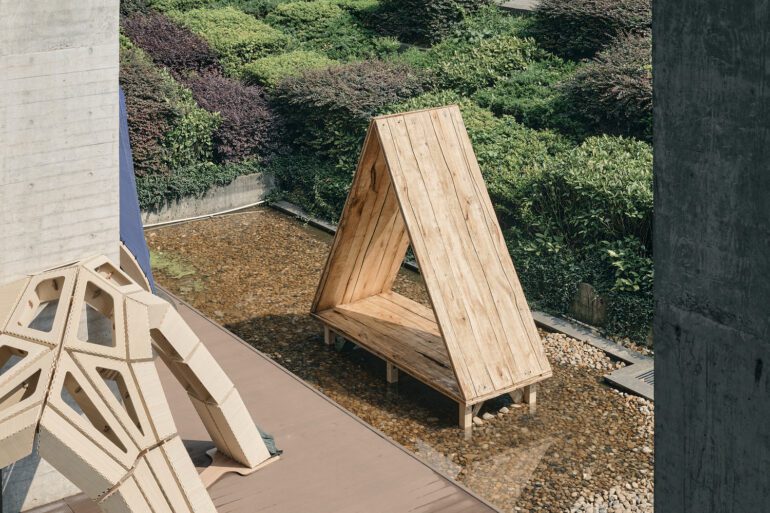TL;DR:
- Mass timber is a sustainable alternative to concrete, reducing global CO2 emissions.
- AI Timber minimizes waste by preserving natural wood contours through AI.
- This innovation reduces the need for standardized cutting, decreasing material waste.
- AI algorithms and digital tools optimize log scanning and assembly.
- Mykola Murashko of Maestro Technologies emphasizes AI’s vital role.
- Interlocking boards in AI Timber improve structural performance.
- This technology bridges design and manufacturing, enabling custom components.
- The result is faster, more efficient, and eco-friendly construction.
- Carlo Ratti’s Maestro startup orchestrates the process seamlessly.
- AI Timber’s debut prototype showcased its potential at a conference.
Main AI News:
In the pursuit of a more sustainable future, the construction industry has witnessed a transformative evolution with the emergence of mass timber as a viable alternative to traditional concrete structures, which account for a staggering 8% of global CO2 emissions. Mass timber has proven its potential to revolutionize construction by offering enhanced efficiency, strength, and comfort. However, even within the realm of standardized and efficient manufacturing processes, there’s always room for improvement and waste reduction. This stems from the conventional practice of cutting logs into standardized boards, a process that generates substantial waste.
Enter AI Timber, a groundbreaking construction material designed to minimize waste by embracing the natural contours of trees. Instead of adhering to conventional methods that involve slicing individual logs into uniform boards, AI Timber ingeniously employs Artificial Intelligence to piece these logs together like a perfectly assembled puzzle. In our quest to delve deeper into this innovative initiative and explore the future of this material, we engaged in a conversation with two pivotal figures in the project, Carlo Ratti and Mykola Murashko.
Wood, as a natural material, inherently reflects the unique conditions of a tree’s growth – factors like climate, prevailing winds, or its position within the forest. A cross-section of a log reveals distinct parts, such as sapwood and heartwood, each endowed with its own unique strength and characteristics. The manner in which a log is cut and transformed into boards or structural components significantly influences the functionality and attributes of the resultant sections. The innovation embedded in AI Timber hinges on harnessing the natural contours of these pieces to curtail waste while preserving the integrity of the wood fibers.
AI algorithms and advanced digital machining tools were deployed to scan raw logs, transform them into boards, and ascertain the optimal configuration for their assembly. The outcome? Wooden panels comprised of interlocking boards that seamlessly align, ensuring minimal removal of natural material from the tree. This groundbreaking method was conceived by Maestro, a dynamic construction technology startup, brought to life through the collaborative efforts of CRA-Carlo Ratti Associati and nurtured by the ingenuity of students and researchers from MIT and Tongji University.
Carlo Ratti elaborates, “Modern industrial production hinges on standardization, but the growth of every tree follows its unique course. When we reduce these distinctive trees into uniform panels, we squander a significant portion of the wood that fails to conform. Our approach is distinct. We leverage LiDAR technology to scan raw logs and employ AI to ingeniously assemble them, making minimal cuts and utilizing every available piece of wood.”
Regarding the technology itself, Mykola Murashko, CEO, and co-founder of Maestro Technologies emphasizes, “Without AI, realizing this material would remain an unattainable dream. The technology empowers us to calculate the optimal sawmilling approach for a set of logs, minimizing wood waste. Our algorithm minimizes the loss function tied to the volume of timber required to create a cohesive CLT layer. Maestro has established an integrated pipeline that seamlessly marries imaging technology with AI, generating bespoke machine instructions for sawmills and CNC machines. Our AI-driven pipeline enables us to deliver artisanal craftsmanship at industrial speeds.“
Mykola further adds, “Beyond aesthetics, the interlocking lamellas within the CLT panel enhance its structural integrity by counteracting shear forces. In essence, the material holds itself together. This potential reduction in the use of adhesives in CLT production holds immense promise for a greener future.”
The overarching goal of this project is to harness technology’s power to bridge the gap between design and manufacturing. It paves the way for a network of suppliers to produce customized components on an unprecedented scale, culminating in transportable and tailor-made buildings. This methodology promises to render construction more efficient, swifter, and more environmentally conscious than ever before. Carlo Ratti envisions, “Maestro, our construction startup, is built on a holistic strategy to revolutionize the construction process. AI timber is just the inaugural piece. We craft bespoke designs within a digital realm, which are then sent to a network of European factories, producing all the custom components. Much like conducting a symphony, Maestro orchestrates the factories in constructing building sections, which are subsequently shipped to the destination as the Maestro Flatpack.”
The inaugural prototype of AI Timber made its debut in Shanghai earlier this summer during the DigitalFUTURES conference, orchestrated by Professor Philip Yuan of Tongji University. Over a one-week workshop, Murashko and Nikita Klimenko from MIT led an international team of researchers in an exploration of AI and wood, culminating in the construction of a proof-of-concept structure – a small, interactive triangular pavilion that showcases the potential of this revolutionary system.

Source: ArchDaily
Conclusion:
The emergence of AI Timber in the construction industry signifies a significant shift towards sustainability, efficiency, and environmental consciousness. By leveraging AI to preserve natural wood contours and optimize assembly, this innovative material reduces waste and paves the way for custom, eco-friendly construction on an unprecedented scale. This development promises to reshape the market, driving demand for sustainable construction materials and methods while enhancing overall industry efficiency.

